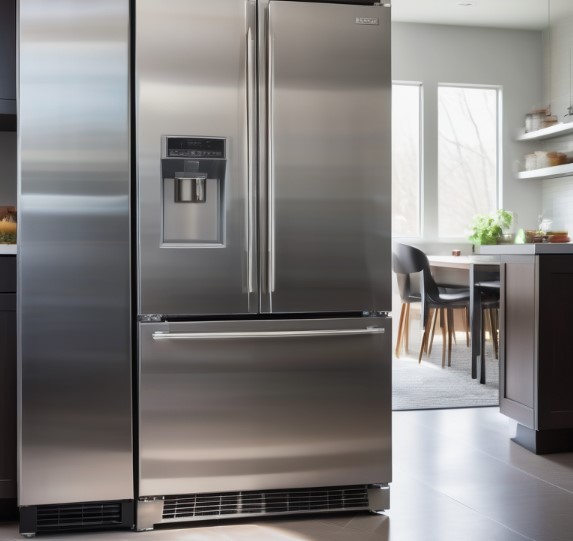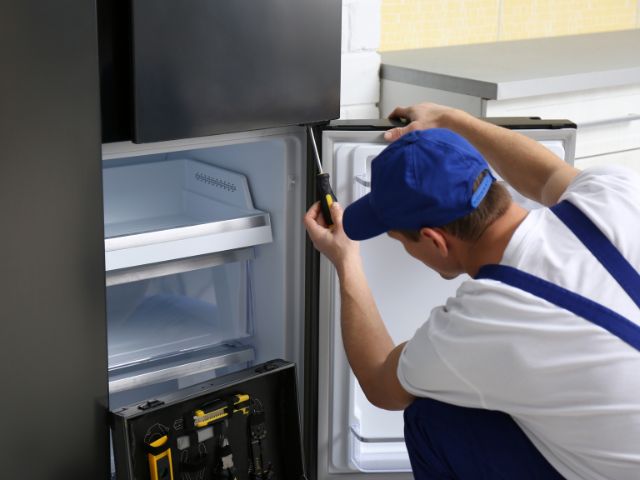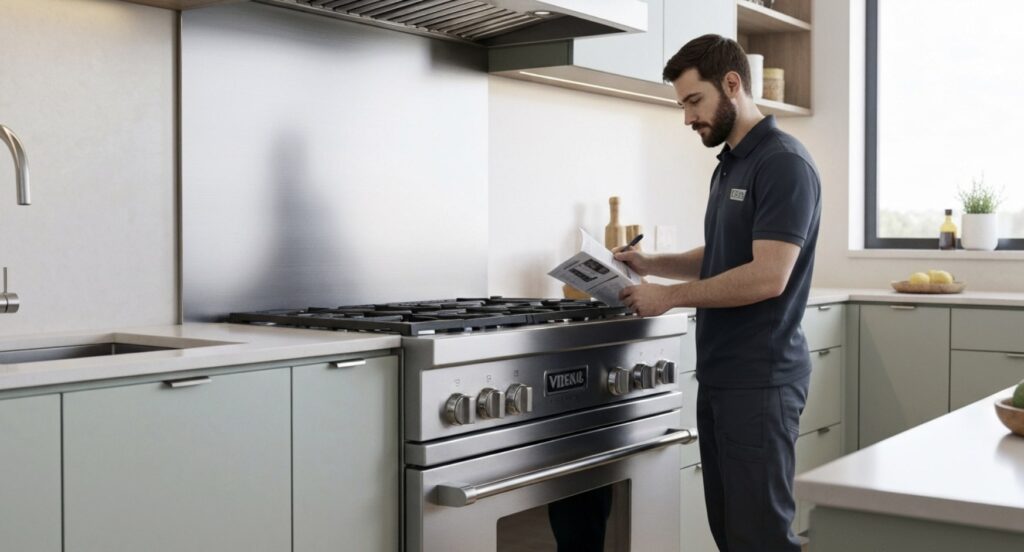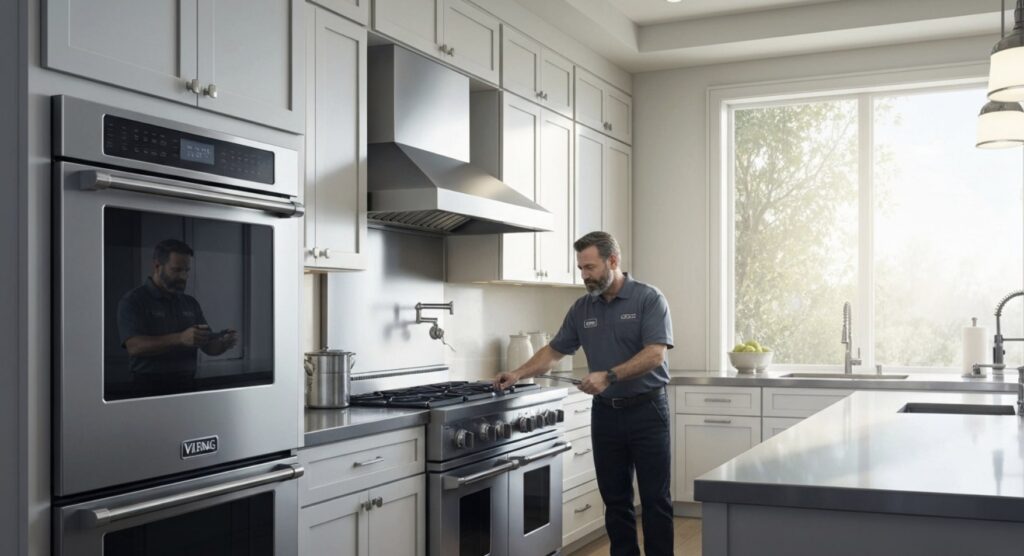Tired of filling ice cube trays by hand? You can make things easier by connecting your Viking ice maker to a water line. This guide will help you step-by-step. You will learn how to connect the ice maker to your water line supply. Whether you are good at DIY projects or just need some help, this guide will give you the knowledge to install the appliance easily.
Preparing for Installation
Before you connect your ice maker to the water line, it helps to prepare well. Getting the tools and materials ready will make things go smoother. This way, you can focus on the steps without any breaks.
Tools and Materials Needed for the Job
Having the right tools and materials close by is important for a smooth installation. You need everything from basic tools to special fittings for a secure and leak-free connection. Here is a complete list to help you get ready:
- Tube Cutter: This tool makes a clean and accurate cut on the water line tubing. Do not use a hacksaw, as it can leave rough edges that may leak.
- Adjustable Wrench: An adjustable wrench gives you the grip needed to tighten connections well and stop leaks.
- 1/4-inch Water Supply Tubing: This tubing carries water from your home’s supply line to the ice maker.
Just double-check that your tubing works with your refrigerator model and local plumbing rules.
Safety Measures to Consider Before Starting
While connecting an ice maker to a water line is not too hard, making safety your top concern is very important. By following these safety steps, you can lower the chance of accidents and have a smooth setup.
First, make sure to turn off the main water supply where you will be working. This helps stop any unwanted water flow and possible flooding. Find the shut-off valve, which is usually under the sink or in the basement, and turn it clockwise until it’s totally closed.
Next, always wear safety glasses when you cut the tubing. This will protect your eyes from any small pieces that might fly off. It is also smart to have a bucket and some towels ready to catch any leftover water in the pipes.
Step-by-Step Guide to Connecting Your Ice Maker to the Water Line
Now that you have the right tools and safety steps ready, we can go through how to connect your ice maker water line. This will help you get a steady flow of cool ice. This guide will break down each step, making it easy for anyone, including DIY beginners. Don’t forget to check your fridge’s user manual for instructions that fit your model.
Step 1: Locating the Nearest Water Supply
The first step to connecting your ice maker water line is to find the best cold water supply line. It’s best to pick a spot that is close to the fridge. This will help you keep the water line short.
Start by looking under your kitchen sink. Most sinks have cold and hot water shut-off valves. These valves are easy to work with. If you can’t find a good spot under the sink, check in your basement or utility room for a water supply line.
After you find a water supply line, think about how the tubing will go to the fridge. Try not to run it through places that might get hot or where it could be squeezed or damaged.
Step 2: Shutting Off the Water Supply
With your water supply line picked, the next important step is to turn off the water. This helps to stop any leaks while you install. This step is very important to keep your area safe and dry.
Find the main shut-off valve for your water supply line. You usually can find this valve under the sink, in the basement, or near your water heater. It often looks like a round handle or a lever. Turning the handle to the right shuts off the water.
To make sure the water is fully shut off, turn on a faucet that is connected to the same line. If no water comes out, you have turned off the supply and can move on to the next step.
Step 3: Installing the Water Line Connector
Now that you’ve turned off the water supply, it’s time to connect your water line to the cold water supply line. You will need a tee fitting for this. This fitting will help you make a strong connection without needing to change the main plumbing.
First, choose the right tee fitting that fits the size of your cold water supply line and the 1/4-inch water line tubing. Wrap the threads of the fitting with Teflon tape. This will create a watertight seal.
Next, attach the tee fitting to the cold water supply line. Use an adjustable wrench to tighten the connection. Make sure it’s secure, but don’t over-tighten it. This could damage the pipe or the fitting.
Step 4: Running the Water Line to the Ice Maker
With the water line connector in place, measure the distance from the tee fitting to the back of your fridge. Add a few extra feet for flexibility. This measurement will tell you how long the 1/4-inch water line tubing needs to be.
Next, use a tube cutter to cut the tubing to the right length. Make sure the cut is straight and does not have any rough edges. After that, carefully move the tubing from the tee fitting to the back of the fridge. Follow the planned path and watch out for any obstacles.
To keep the water line tubing in place and avoid kinks, attach it to the wall or cabinets every few feet. Use pipe clamps or clips for this. Also, make sure the tubing slopes slightly downward toward the fridge to allow proper water flow.
Step 5: Connecting the Water Line to the Ice Maker
At this point, take the other end of the 1/4-inch water line tubing. Feed it through the opening at the back of your fridge. This opening is meant for the ice maker connection. You can usually find it near the bottom of the refrigerator, close to the compressor.
Now, find the water inlet valve on your ice maker. This valve is a small, threaded spot where the water line tubing connects. It is usually labeled to help you find it easily.
Carefully push the tubing onto the inlet valve until it is all the way on. Make sure it fits snugly. Depending on the model of your refrigerator, you may need a compression nut or a push-to-connect fitting to keep it securely in place.
Step 6: Turning On the Water Supply and Checking for Leaks
With all the connections secure, it’s time to turn the water supply back on and check for leaks. This step is very important. It helps prevent water damage and makes sure the installation is done right.
To start, slowly turn the main water supply valve counterclockwise. This will gradually bring water back into the pipes. Doing it slowly helps reduce the chance of sudden bursts. Once the water flows freely, check each connection point carefully. Look at the tee fitting, the back of the fridge, and the ice maker inlet valve.
Watch for any signs of dripping water or puddles around the connections. If you see any leaks, turn off the water supply right away. Then, check the connections again to make sure they are tightly sealed.
Testing and Troubleshooting
Once you have checked and confirmed that there are no leaks, it is time to test the ice maker. You need to see if it is getting water and making ice like it should. This checks if your installation worked well.
Start by turning on the ice maker using the control panel on your refrigerator. Then, give it several hours to go through its freezing process and make the first batch of ice cubes. The first batch may take a bit longer than usual, but the next ones should follow the normal speed. If your ice maker isn’t making ice after a few hours or seems to be broken, check all the connections again. You may also want to look at your refrigerator’s troubleshooting guide for help.
Ensuring a Secure Connection
Even when your ice maker is working well, it is important to check it regularly. This will help keep the connection safe and stop any leaks in the future. Over time, vibrations and changes in water pressure can loosen the connections. This can cause slow drips or even more serious problems.
Make sure to inspect the connection points at the tee fitting, the back of the fridge, and the ice maker inlet valve. Check that the connections are tight and have no rust or damage. Also, feel around the connections for any moisture or dampness. This can suggest a slow leak.
If you find a loose connection, you can use an adjustable wrench to tighten it gently. Be careful not to over-tighten, as this could strip the threads or damage the fitting. Regularly checking these connections will help your ice maker water line last longer and prevent any water damage in your home.
What to Do If Your Ice Maker Isn’t Working
If your ice maker is not making ice like you expect, a few common reasons could be the issue. Before you call a professional, you can try to fix these problems to get your ice back.
First, check if the ice maker is turned on using the control panel in your fridge. Sometimes, a small bump or power surge can accidentally turn it off. Also, look to see if the ice maker arm is in the down or “on” position to start making ice.
Next, make sure the water supply line to the ice maker is not bent or blocked. A kink or block can stop water from flowing, which can mean you get little or no ice. Check the tubing from the back of the fridge to the ice maker and fix any kinks or blocks you find.
Maintenance Tips for Your Ice Maker’s Water Line
Taking care of your ice maker water line is very important. It helps your ice maker last longer and keeps fresh ice flowing. Good maintenance can help you avoid problems like leaks, clogs, or less ice being made. By following these tips, you can save time and money and avoid future headaches.
Routine Checks to Prevent Leaks
Preventing leaks is very important to keep your ice maker working well and to protect your home from water damage. By doing simple and regular checks, you can lower the risk of unexpected leaks a lot.
First, check the water line now and then. Look closely at the connection points behind the refrigerator and under the sink. Look for signs like dripping water, dampness, or stains. Touch the connections lightly to feel for moisture, which can mean there is a slow leak. Next, look at the water line tubing for any cracks, wear, or damage. If you see any problems, replace those parts right away. Over time, the tubing can get weak or worn down from vibrations, which can lead to leaks.
Finally, pay attention to ice build-up in the ice maker. This can sometimes cause leaks too. If you see too much frost or ice, defrost the ice maker. This will help with proper drainage and stop water from overflowing.
When to Replace Your Ice Maker’s Water Line
Knowing when to change your ice maker’s water line is important. This helps you avoid leaks and water damage. Doing regular maintenance can help it last longer. However, some signs tell you it’s time for a replacement. This helps keep it working well.
First, if you see leaks that don’t go away, even after fixing connections or changing fittings, it may mean the water line needs replacing. Also, if you notice cracks, brittleness, or color changes in the tubing, this shows it’s weak. It could leak easily.
If your ice maker is not getting enough water, causing small ice cubes or less ice, the water line might be blocked. In this case, changing the water line can improve the water flow and fix the problem.
Conclusion
In conclusion, connecting your ice maker to the water line is an easy task with the right help. First, follow safety rules. Next, find the water supply. Then, connect the water line securely. Regular maintenance can help you avoid leaks and keep everything working smoothly. If you have problems, Viking Appliance Repair Pros can help you fix them. For more ice maker tips, check our blog on Troubleshooting Viking Ice Maker Not Filling with Water. Remember, a good water line helps your ice maker produce ice well and makes the appliance last longer.
Frequently Asked Questions
How often should I check the connections for leaks?
It’s a good idea to check the connections of your ice maker water line for leaks every 3 to 6 months. You should check more often if the seasons change or if you see any changes in how much ice your ice maker makes. This way, you can fix any potential problems quickly.
Is it necessary to use a filter with my ice maker water line?
Using a filter for your ice maker water line is not required, but it is strongly advised. A filter can enhance the taste and quality of your ice. It helps remove chlorine, dirt, and other unwanted elements. This results in clearer ice that tastes better in your drinks.
Can I install the water line myself or should I hire a professional?
Installing an ice maker water line can be a DIY project if you have basic plumbing skills. However, if you feel unsure or uncomfortable, it’s a good idea to hire a licensed plumber. A professional can help with a proper and safe installation. This way, you can relax, knowing that you are avoiding any plumbing problems down the line.







